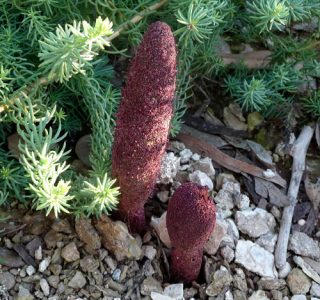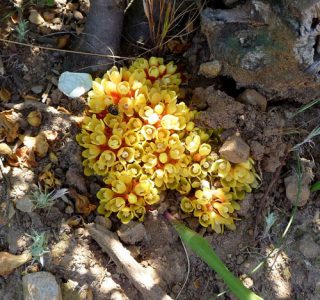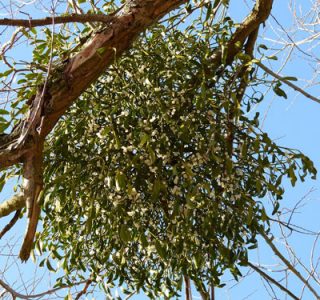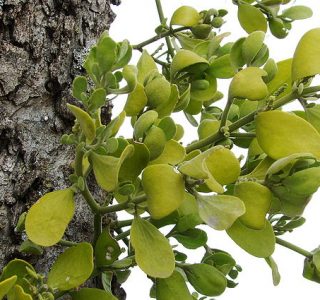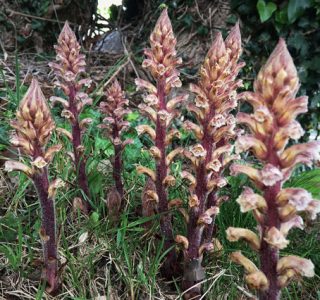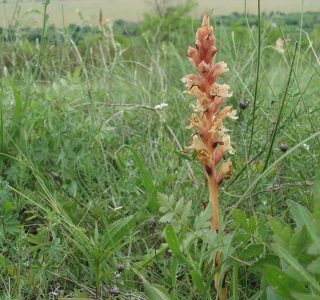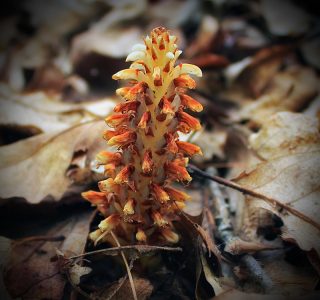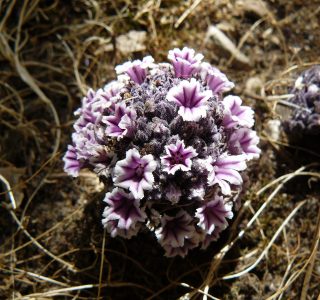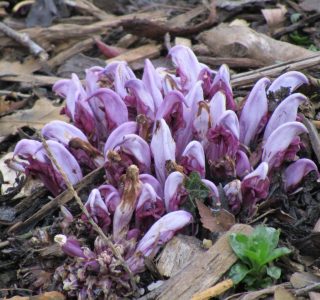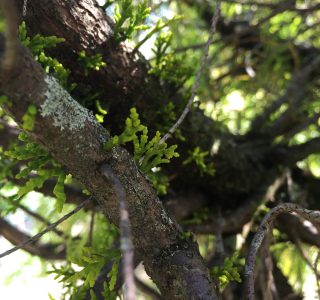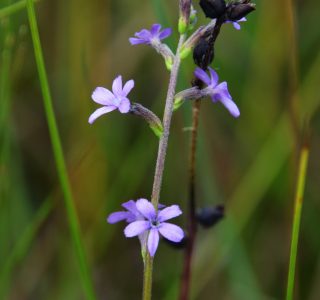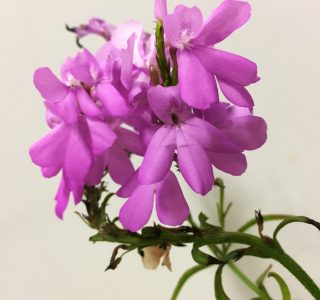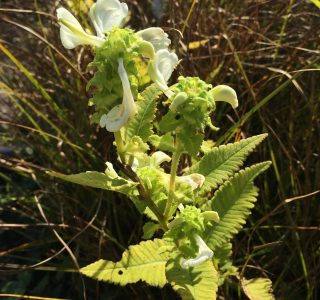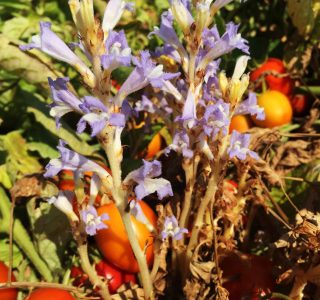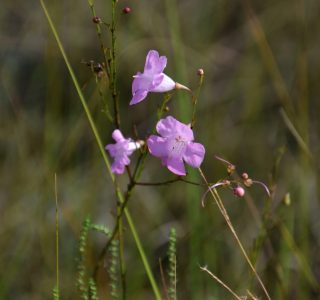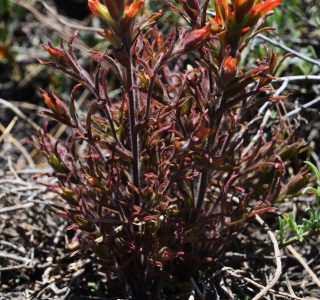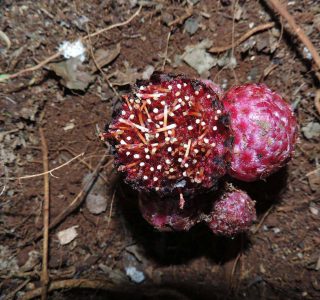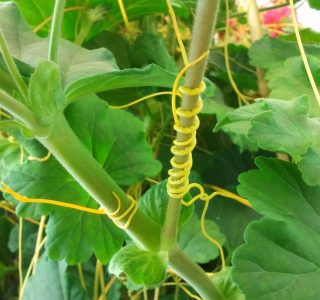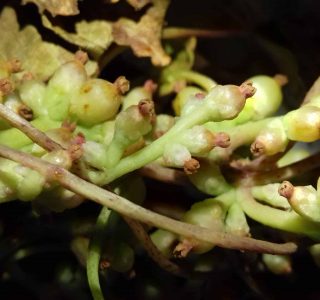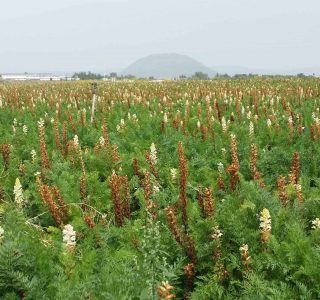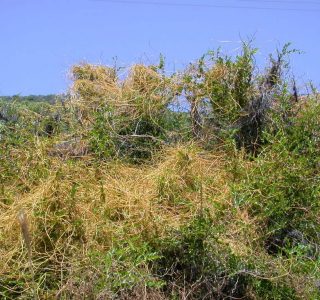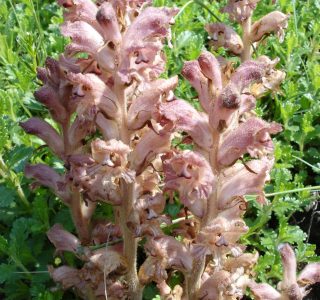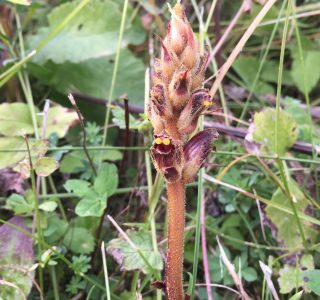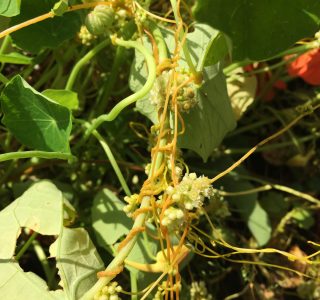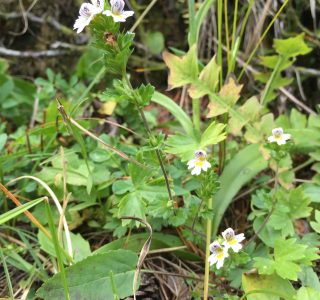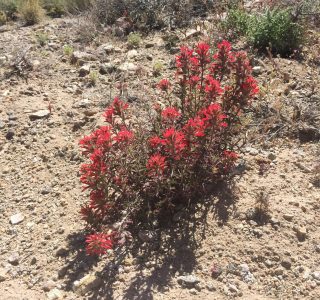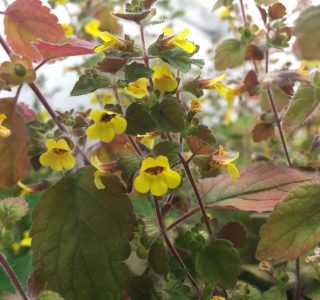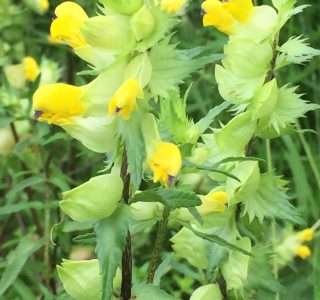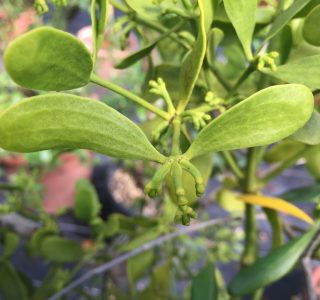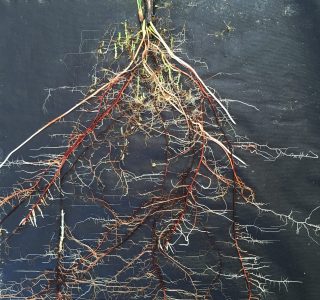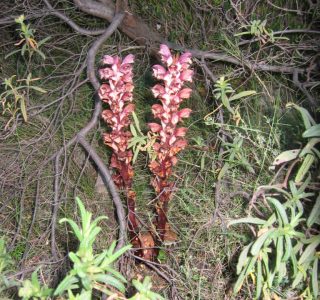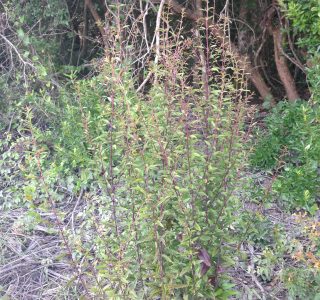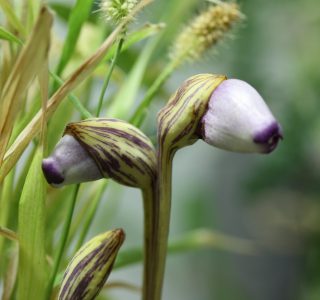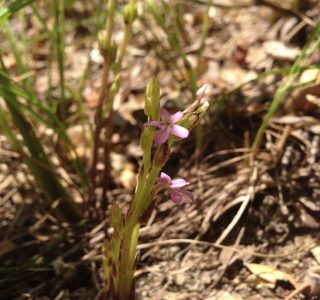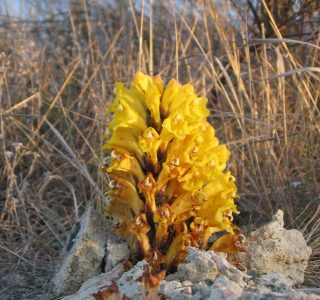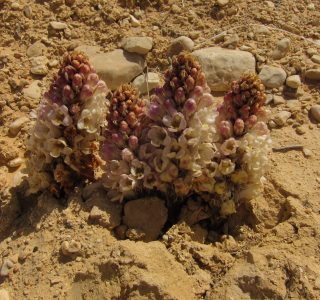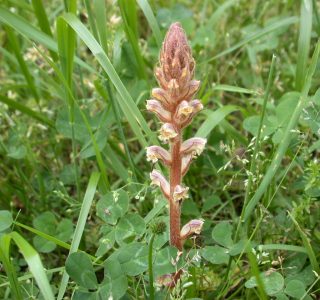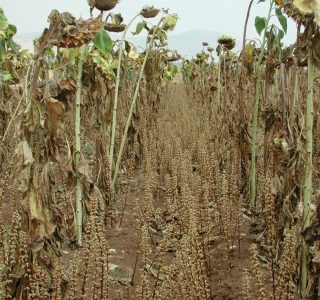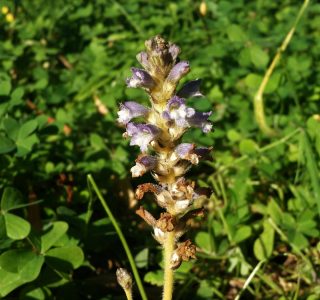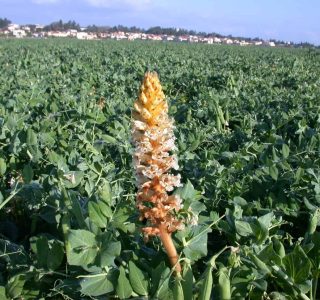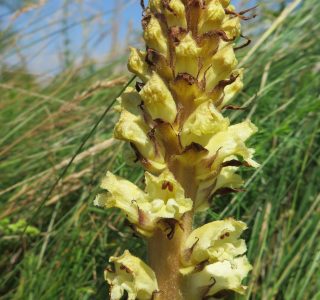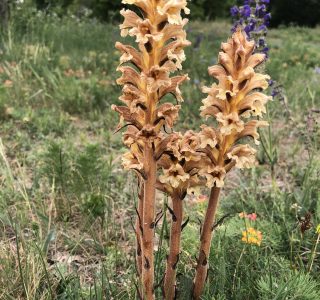
International Parasitic Plant Society
Welcome to the homepage of the International Parasitic Plant Society (IPPS). The IPPS is dedicated to advancing scientific research on parasitic plants. Our goals include increasing the understanding of these amazing plants, providing a platform for exchange among and beyond the scientific community as well as helping to decrease the crop damage inflicted by weedy parasitic plants.
Latest News
- Striga Germination Stimulant Analysis
- Mutation Breeding and Efficiency Enhancing Technologies for Resistance to Striga in Cereals
- Researchers Identify Microbes That Help Plants Thwart Parasite
- New paper: Host interactions, pathology, economic impacts and management of the facultative parasitic weed Rhamphicarpa fistulosa
- Screening tropical and sub‑tropical maize germplasm for resistance to Striga hermonthica and S. asiatica and yield‑related traits
- New paper: “Macronutrient application rescues performance of tolerant sorghum genotypes when infected by the parasitic plant striga”
Upcoming: The 17th World Congress On Parasitic Plants (WCPP): 3–7 June 2024, Nara, Japan.
For more information see the website and Society news
Member benefits
Discount
Get a member discount for our biennial congress
Meet
Entry in and access to the member’s directory
Inform & get informed
Have access to IPPS seminars; post news on parasitic plants
Meet our talent
Post vacancies for jobs in parasitic plant research
A picture tells
Non-commercial usage rights of the photo gallery
Most recent ‘Parasitic Plant’ publications
on the Web
Incredible Host Diversity and Regional Potential Distribution of an Oriental Parasitic Plant (Taxillus yadoriki)
C Lee, B Choi, E Park, E Yim - Forests, 2024 - mdpi.com
Wednesday 01 May 2024
This study investigates the host diversity and characteristics of the rare parasitic
plant Silverberry-like taxillus (Taxillus yadoriki). Seogwipo, Jeju Island, where T. yadoriki
domain : www.mdpi.com
Understanding life cycle of parasitic weed Phelipanche ramosa infesting Brassica juncea in India: new host species and seed coat structure
A Watts, RK Raipuria, A Chaudhary… - Journal of Crop …, 2024 - Taylor & Francis
Monday 29 April 2024
Broomrape (Phelipanche ramosa) is an obligate root parasitic plant that is
known to infest many important crops. It is emerging as a serious biotic threat for Brassica
domain : www.tandfonline.com
azı gübrelerin ve bitki gelişim düzenleyicilerin patateste sorun olan canavar otuna (Orobanche spp.) karşı etkilerinin araştırılması
F Turgan - acikbilim.yok.gov.tr
Friday 26 April 2024
On the control of broomrape (Orobanche spp.) were As a result of the study,
the lowest broomrape branch , while the highest number of broomrape branches per plot was (
domain : acikbilim.yok.gov.tr
Strigolactones: Coordination with other Phytohormones and Enhancement of Abiotic Stress Responses
P Sharma, AB Jha, RS Dubey - Environmental and Experimental Botany, 2024 - Elsevier
Wednesday 24 April 2024
The germination of parasitic plants like Striga, Orobanche, and Phelipanche
species ( from being primarily associated with parasitic plant biology to becoming prominent
domain : www.sciencedirect.com
A new species of Striga (Orobanchaceae) from Odisha state, India
RS Devi, S Kumar - researchgate.net
Wednesday 24 April 2024
After a thorough analysis of relevant literature and herbarium specimens of
all the Striga species of India and adjacent countries, proved it to be a new species hitherto
domain : www.researchgate.net
ECO-FRIENDLY MANAGEMENT OF FALL ARMYWORM, Spodoptera frugiperda (JE SMITH) IN MAIZE
MPK Sampat - 2024 - krishikosh.egranth.ac.in
Wednesday 24 April 2024
Maize (Zea mays L.) is one of the most important cereal crops cultivated all
over the world for both human and animal sustenance. It is known as the" Queen of Cereals"
domain : krishikosh.egranth.ac.in
versions : 2
Screening and Identification of Potential Striga [Striga hermonthica (Del.)] Suppressing Rhizobacteria Associated with Sorghum [Sorghum bicolor (L.) Moench] …
UT Tulu, T Haileselassie, S Abera… - Technology in …, 2024 - maxapress.com
Tuesday 23 April 2024
, Striga, insect pests, poor soil fertility, and diseases. Among the constraints,
Striga (genus), also called witch weed, practically effective to eradicate Striga, neither they are
domain : www.maxapress.com
versions : 2
Evaluation of Western Ethiopian Sorghum Landraces for Resistance to Striga hermonthica (Del.) Benth
MK Earecho, E Nebiyu - 2024 - researchsquare.com
Tuesday 23 April 2024
Striga resistant or tolerant sorghum would form a great part of an integrated
Striga to the effects of Striga parasitism. Early maturing sorghum landraces have the lowest
domain : www.researchsquare.com
Cereal production in Africa: the threat of certain pests and weeds in a changing climate—a review
J Benjamin, O Idowu, OK Babalola, EV Oziegbe… - Agriculture & Food …, 2024 - Springer
Sunday 21 April 2024
Parasitic plants such as mistletoe, dodder, and witchweed attach themselves
to host plants and tap into their vascular systems to obtain nutrients, further impacting the host
domain : link.springer.com
versions : 3
Genetic potential and inheritance pattern of agronomic traits in faba bean under free and infested Orobanche soil conditions
AA Soliman, MA Ibrahim, MI Mousa… - BMC Plant …, 2024 - bmcplantbiol.biomedcentral.com
Saturday 20 April 2024
Orobanche is an obligate parasite on faba bean in the Breeding tolerant
faba bean genotypes to Orobanche is were evaluated under Orobanche free and naturally
domain : bmcplantbiol.biomedcentral.com
versions : 2
МАТЕРИАЛЫ ПУЛА НАУЧНО-ПРАКТИЧЕСКИХ КОНФЕРЕНЦИЙ
НД УШАКОВА, ТВ СВИСТУН, НИ КОНОПЛЯ - elibrary.ru
Friday 19 April 2024
.
domain : elibrary.ru
Evaluation of granular formulated strigolactone analogs for Striga suicidal germination
M Jamil, O Margueritte, D Yonli, JY Wang… - Pest management … - pubmed.ncbi.nlm.nih.gov
Thursday 18 April 2024
The dependency of Striga seed Striga seed germination at a rate of up to
43%. With 10 mg granular product (0.75 mg ai) per pot, we observed 77-83% reduction in Striga
domain : pubmed.ncbi.nlm.nih.gov
Parasitic dodder expresses an arsenal of secreted cellulases with multi-substrate specificity during host invasion
H Edema, T Bawin, S Olsen, K Krause… - Plant Physiology and …, 2024 - Elsevier
Thursday 18 April 2024
Cuscuta campestris is a common and problematic parasitic plant which relies
on haustoria to connect to and siphon nutrients from host plants. Glycoside hydrolase family
domain : www.sciencedirect.com
Global changes in gene expression during compatible and incompatible interactions of faba bean (Vicia faba L.) during Orobanche foetida parasitism
A Boukteb, K Sato, P Gan, M Kharrat, H Sakouhi… - PLOS …, 2024 - journals.plos.org
Wednesday 17 April 2024
Indeed, in heavily infested fields with this parasitic plant, yield losses may reach
90% -parasitic plant interactions. Furthermore, considering the pivotal role of parasitic plant
domain : journals.plos.org
Response of Wheat and Faba Bean to Intercropping and Tillage System on a Mediterranean Rainfed Vertisol
RJ Lopez-Bellido, V Muñoz-Romero… - Agricultural …, 2024 - Springer
Wednesday 17 April 2024
Glyphosate was applied to the faba bean plots at a rate of 0.065 L active
ingredient ha 1 as a postemergence spray when the broomrape (Orobanche crenata Forsk) was
domain : link.springer.com
Most recent 'Parasitic Plant' publications
in Scopus
- Cuscuta chinensis flavonoids alleviate ovarian damage in offspring female mice induced by BPA exposure during pregnancy by regulating the central carbon metabolism pathway Qianhui Zhao, Ying Liu, Yanan Chuo, Xiao Wang, Yulan Jiao, Wanyu Shi, Yongzhan Bao Ecotoxicology and Environmental Safety, volume 275 Saturday 04 May 2024 Pregnancy is a sensitive window period for bisphenol A (BPA) exposure. BPA can pass through the placenta and cause reproductive damage in offspring female mice. Even BPA that is not metabolized during lactation can be passed through milk. Cuscuta chinensis flavonoids (CCFs) can alleviate reproductive damage caused by BPA, but the mechanism of actio... Pregnancy is a sensitive window period for bisphenol A (BPA) exposure. BPA can pass through the placenta and cause reproductive damage in offspring female mice. Even BPA that is not metabolized during lactation can be passed through milk. Cuscuta chinensis flavonoids (CCFs) can alleviate reproductive damage caused by BPA, but the mechanism of action is unclear. To investigate the potential mitigating impact of CCFs on ovarian damage resulting from BPA exposure during pregnancy, we administered BPA and CCFs to pregnant mice during the gestational period spanning from 0.5 to 17.5 days. Aseptic collection of serum and ovaries from female mice was conducted on postnatal day 21 (PND21). Serum hormone levels and tissue receptor levels were quantified utilizing ELISA and PCR, while ovaries underwent sequencing and analysis through transcriptomics and metabolomics techniques. Additionally, the assessment of ovarian oxidative stress levels was carried out as part of the comprehensive analysis. The results showed that CCFs administration mitigated the adverse effects induced by BPA exposure on ovarian index, hormone levels, receptor expression, and mRNA expression levels in female offspring mice. The joint analysis of transcriptome and metabolome revealed 48 enriched pathways in positive ion mode and 44 enriched pathways in negative ion mode. Among them, the central carbon metabolism pathway is significantly regulated by BPA and CCFs. The screened sequencing results were verified through qPCR and biochemical kits. In this study, CCFs may participate in the central carbon metabolism pathway by reducing the expression of Kit proto-oncogene (Kit), hexokinase 1 gene (Hk1) and pyruvate kinase M (Pkm) mRNA and increasing the expression of h-ras proto-oncogene (Hras), sirtuin 3 (Sirt3), sirtuin 6 (Sirt6) and TP53 induced glycolysis regulatory phosphatase gene (Tigar) mRNA, thereby resisting the effects of BPA on the body. At the same time, the metabolic levels of D-Fructose 1,6-bisphosphate and L-Asparagine tend to be stable. Moreover, CCFs demonstrated a capacity to diminish the BPA-induced escalation in reactive oxygen species (ROS) and malondialdehyde (MDA). Simultaneously, it exhibited the ability to elevate levels of glutathione (GSH) and catalase (CAT), thereby effectively preventing peroxidation. In summary, CCFs alleviate BPA-induced ovarian damage in offspring female mice by regulating the central carbon metabolism pathway. This study will improve the information on BPA reproductive damage antagonist drugs and provide a theoretical basis for protecting animal reproductive health.
- Infection of juniper trees (Juniperus excelsa M. Bieb.) to juniper dwarf mistletoe (Arceuthobium oxycedri (D.C.) M. Bieb) in forests of Miankouh Tash protected area, Shahroud D. Kartoolinejad, H. Ravanbakhsh, Z. Fadaei, A. R. Moshki, E. Nikouee Iranian Journal of Forest, volume 15, pages 497-514 Friday 03 May 2024 Introduction and Objective: Juniper stands, renowned for their ecological role, are facing a recent threat from the proliferation of a parasitic plant known as the juniper dwarf mistletoe, scientifically named Arceuthobium oxycedri. The primary objective of this study is to assess the extent of this disease among juniper trees in the Miankoh Tash r... Introduction and Objective: Juniper stands, renowned for their ecological role, are facing a recent threat from the proliferation of a parasitic plant known as the juniper dwarf mistletoe, scientifically named Arceuthobium oxycedri. The primary objective of this study is to assess the extent of this disease among juniper trees in the Miankoh Tash region. Materials and Methods: A 250×250-meter grid was systematically established, comprising 65 square-shaped sample plots, each measuring 20×20 meters. Within each sample plot, various quantitative characteristics of juniper trees, such as tree height, crown diameter, collar diameter, canopy coverage percentage, and the presence of branch dieback, were meticulously measured. Furthermore, habitat factors, including elevation, slope, geographical direction, soil erosion status beneath the juniper crown (classified into four categories), and tree root exposure (classified into three categories), were meticulously documented. The collected data underwent analysis utilizing both univariate and discriminant analysis techniques. Results: Our results suggest that the gender of the host individuals, slope percentage, and geographical direction had no significant impact on the severity of infection. However, infected host trees displayed higher average values in tree height (5 meters), crown diameter (3.7 meters), collar diameter (54.7 cm), and crown area (12.8 square meters) compared to healthy junipers (3.1 m, 2.1 m, 24.1 cm, and 4.1 m², respectively). Moreover, the frequency of branch dieback, a common symptom of dwarf mistletoe invasion, was notably higher in infected trees. Discriminant analysis identified several key indicators of juniper dwarf mistletoe severity, including the severity of erosion under the canopy, root exposure, collar diameter of trees, collar diameter of trees per hectare, crown diameter, and tree height. Conclusion: The study concludes that larger, and thus older, trees are more susceptible to juniper dwarf mistletoe infection. Additionally, juniper trees with increased root exposure and soil erosion on their canopy surface, indicative of livestock overgrazing, exhibit a heightened susceptibility to parasitic plant invasion. This underscores the compounding effects of livestock grazing pressure on host trees. Therefore, prioritizing non-destructive methods to control juniper dwarf mistletoe, particularly in areas with old and large juniper trees, is recommended.
- Screening tropical and sub-tropical maize germplasm for resistance to Striga hermonthica and S. asiatica and yield-related traits Emeline N. Dossa, Hussein Shimelis, Admire I.T. Shayanowako, Mark D. Laing Euphytica, volume 220 Thursday 02 May 2024 Identification of maize germplasm with dual resistance to Striga hermonthica (Sh) and S. asiatica (Sa), could lead to the development of cultivars with stable resistance. 130 tropical and sub-tropical maize germplasms, including checks, were evaluated in a controlled environment for their reaction to Sh and Sa infestations using a 13 × 10 alpha la... Identification of maize germplasm with dual resistance to Striga hermonthica (Sh) and S. asiatica (Sa), could lead to the development of cultivars with stable resistance. 130 tropical and sub-tropical maize germplasms, including checks, were evaluated in a controlled environment for their reaction to Sh and Sa infestations using a 13 × 10 alpha lattice design with two replications over two seasons. Significant differences (P < 0.05) were detected among the assessed genotypes for all the recorded traits in Sh and Sa-infested treatments. Under Sa-infested conditions, mean Striga emergence counts 8 weeks after planting (SEC8) and 10 weeks after planting (SEC10) were 5.00 and 45.50, respectively, while the mean Striga damage rate 8 weeks after planting (SDR8) and 10 weeks after planting (SDR10) were 3.35 and 3.07, respectively. Under Sh-infested conditions, SEC8 and SEC10 mean values were 3.66 and 3.77, respectively, while the SDR8 and SDR10 values were 5.25 and 2.75 respectively. Positive and significant (P < 0.05) correlations were found between anthesis-silking interval (ASI) and SDR8 (r = 0.18) and SDR10 (0.32) under Sa-infested conditions. Negative and significant correlations were recorded between ear per plant (EPP) and SEC8, SDR8, and SDR10, with r = − 0.18, r = − 0.27, and r = − 0.24, respectively. Under Sh-infested conditions, significant and negative correlations were recorded between SDR8 and EPP (r = − 0. 20), EHT and SEC8 (r = − 0.22), EHT and SDR8 (r = − 0.36), PLHT and SDR8 (− 0.48), and PLHT and SDR10 (− 0.22). The results suggest that dual resistance to the two Striga species exists in some tropical and sub-tropical maize lines. The following genotypes have dual resistance to Sa and Sh: CML440, CML566, CML540, CML539, CLHP0343, CLHP0326, TZISTR1248, TZSTRI115, TZISTR25, TZISTR1205, TZSTRI113, TZISTR1119, TZISTR1174 and the OPVs B.King/1421, Shesha/1421, ZM1421, DTSTR-W SYN13, DTSTR-Y SYN14, and 2*TZECOMP3DT/WhiteDTSTRSYN) C2. The identified genotypes are suitable for use as parents in developing high-performing maize varieties with Striga resistance and improved grain yield.
- Management of the Striga epidemics in pearl millet production: a review Armel Rouamba, Hussein Shimelis, Inoussa Drabo, Kwame Wilson Shamuyarira, Emmanuel Mrema CABI Agriculture and Bioscience, volume 5 Wednesday 01 May 2024 Pearl millet (Pennisetum glaucum [L.] R. Br.) is a drought-resilient and nutritious staple food crop widely cultivated in arid and semi-arid regions. Worldwide, pearl millet is ranked the 6th most widely produced cereal crop after wheat, rice, maize, barley, and sorghum, with a total production of 30.5 million tons on 32.1 million hectares. In Burk... Pearl millet (Pennisetum glaucum [L.] R. Br.) is a drought-resilient and nutritious staple food crop widely cultivated in arid and semi-arid regions. Worldwide, pearl millet is ranked the 6th most widely produced cereal crop after wheat, rice, maize, barley, and sorghum, with a total production of 30.5 million tons on 32.1 million hectares. In Burkina Faso, it is the 3rd widely cultivated crop next to sorghum and maize, with a mean yield of 0.8 ton ha−1, far below the potential yield of 3.0 tons ha−1 attributable to various production challenges. Among the production constraints, the parasitic weed Striga species, particularly S. hermonthica is endemic and causes up to 80% yield losses under heavy infestation. Different control methods (e.g., cultural practices, chemicals and bio-herbicides) have been recommended, but they have been largely ineffective due to diverse and complex problems, including the life cycle, seed production, and prolonged seed dormancy of S. hermonthica; poor access and cost of implementation. Breeding for host plant resistance presents a cost-effective, environmentally friendly and affordable method for smallholder farmers to control and reduce Striga infestations and improve pearl millet yields. Therefore, the objectives of this study were to present the impact of S. hermonthica damage on pearl millet production and productivity and assess the effectiveness of different management methods of S. hermonthica with an emphasis on host plant resistance. The first section of the review assesses the impact of Striga infestation on pearl millet production, followed by the developmental stages of Striga, Striga infestation and damage management strategies, breeding for Striga resistance and other Striga control methods. The paper summarises genetic resources, new breeding technologies, and innovations for the precision and speed breeding of Striga-resistant cultivars. The review will guide the use of the best breeding strategies and accelerate the breeding of new pearl millet cultivars that are best-performing and resistant to S. hermonthica to reduce damage incurred by Striga infestations on farmers’ fields in Burkina Faso and related agro-ecologies.
- Exploring the Protective Effect of Total Flavonoids from Semen Cuscutae on Ovarian Germline Stem Cells Based on Notch Signaling Pathway Yuan Li, Hanqian Du, Jiashan Li, Zehui Li, Li Guo, Panyu Xu, Ying Xu, Na Lin Stem Cell Reviews and Reports, volume 20, pages 852-854 Wednesday 01 May 2024 dc:description
- Comparative secretome analysis of Striga and Cuscuta species identifies candidate virulence factors for two evolutionarily independent parasitic plant lineages James M. Bradley, Roger K. Butlin, Julie D. Scholes BMC Plant Biology, volume 24 Tuesday 30 April 2024 Background: Many parasitic plants of the genera Striga and Cuscuta inflict huge agricultural damage worldwide. To form and maintain a connection with a host plant, parasitic plants deploy virulence factors (VFs) that interact with host biology. They possess a secretome that represents the complement of proteins secreted from cells and like other pl... Background: Many parasitic plants of the genera Striga and Cuscuta inflict huge agricultural damage worldwide. To form and maintain a connection with a host plant, parasitic plants deploy virulence factors (VFs) that interact with host biology. They possess a secretome that represents the complement of proteins secreted from cells and like other plant parasites such as fungi, bacteria or nematodes, some secreted proteins represent VFs crucial to successful host colonisation. Understanding the genome-wide complement of putative secreted proteins from parasitic plants, and their expression during host invasion, will advance understanding of virulence mechanisms used by parasitic plants to suppress/evade host immune responses and to establish and maintain a parasite-host interaction. Results: We conducted a comparative analysis of the secretomes of root (Striga spp.) and shoot (Cuscuta spp.) parasitic plants, to enable prediction of candidate VFs. Using orthogroup clustering and protein domain analyses we identified gene families/functional annotations common to both Striga and Cuscuta species that were not present in their closest non-parasitic relatives (e.g. strictosidine synthase like enzymes), or specific to either the Striga or Cuscuta secretomes. For example, Striga secretomes were strongly associated with ‘PAR1’ protein domains. These were rare in the Cuscuta secretomes but an abundance of ‘GMC oxidoreductase’ domains were found, that were not present in the Striga secretomes. We then conducted transcriptional profiling of genes encoding putatively secreted proteins for the most agriculturally damaging root parasitic weed of cereals, S. hermonthica. A significant portion of the Striga-specific secretome set was differentially expressed during parasitism, which we probed further to identify genes following a ‘wave-like’ expression pattern peaking in the early penetration stage of infection. We identified 39 genes encoding putative VFs with functions such as cell wall modification, immune suppression, protease, kinase, or peroxidase activities, that are excellent candidates for future functional studies. Conclusions: Our study represents a comprehensive secretome analysis among parasitic plants and revealed both similarities and differences in candidate VFs between Striga and Cuscuta species. This knowledge is crucial for the development of new management strategies and delaying the evolution of virulence in parasitic weeds.
- Landscape-level likelihood estimation of eastern spruce dwarf mistletoe (Arceuthobium pusillum) infestations in lowland black spruce (Picea mariana) forests of Minnesota, USA Ella R. Gray, Matthew B. Russell, Marcella A. Windmuller-Campione Canadian Journal of Forest Research, volume 54, pages 409-420 Tuesday 30 April 2024 Biotic disturbance agents are important factors influencing forest dynamics; incorporating them into management planning requires a detailed understanding of their distribution, prevalence, and effects on stand dynamics. However, this information can be difficult to collect in remote forest systems, such as lowland black spruce (Picea mariana (Mill... Biotic disturbance agents are important factors influencing forest dynamics; incorporating them into management planning requires a detailed understanding of their distribution, prevalence, and effects on stand dynamics. However, this information can be difficult to collect in remote forest systems, such as lowland black spruce (Picea mariana (Mill.) B.S.P.) forests affected by eastern spruce dwarf mistletoe (Arceuthobium pusillum Peck, hereafter ESDM). In such cases, predictive modeling is often needed to inform management decisions and address forest health questions. Here, we used two publicly available datasets to predict areas where black spruce is more likely to be infested with ESDM in northeastern Minnesota, USA. Using random forest modeling and logistic regression, we found location, stand age, basal area, site index, average diameter, and metrics of species composition to be among the most important predictors of ESDM occurrence. Predictions showed two regions of greater likelihood of infestation with distinct ecological characteristics and ownership patterns. By understanding how stand structural characteristics relate to ESDM infestations, managers can improve monitoring and management of ESDM at the stand and landscape scales. Additionally, our approach of using multiple datasets and modeling methods can serve as a framework for decision-making on other forest health concerns.
- Spatial distribution of woody plants in relation to mistletoe-infected Vachellia karroo trees in a semi-arid African savanna Tsitsi Sithandiwe Maponga, Hilton Garikai Taambuka Ndagurwa, Justice Muvengwi, Ed T.F. Witkowski Global Ecology and Conservation, volume 51 Monday 29 April 2024 By increasing resource heterogeneity, mistletoe-infected trees can restructure plant community processes and distribution patterns. No information is available on how mistletoe-infected Vachellia (Acacia) karroo trees within V. karroo dominated stands are spatially distributed, and on how they influence the spatial patterns of their surrounding con... By increasing resource heterogeneity, mistletoe-infected trees can restructure plant community processes and distribution patterns. No information is available on how mistletoe-infected Vachellia (Acacia) karroo trees within V. karroo dominated stands are spatially distributed, and on how they influence the spatial patterns of their surrounding conspecifics and heterospecifics. Each woody plant was stem mapped using a cartesian plane (x, y) within three 50×50 m plots located in V. karroo dominated stands in a semi-arid savanna, South West Zimbabwe. Pair correlations g(r) were used for the univariate analysis and Poisson process null models were applied to quantify and detect overall departure from randomness. For the bivariate analysis, pair correlations g12(r) under the null model of independence were used, whilst the mark correlation function (kmm(r)) was used to analyse the correlation of tree canopy area and mistletoe infection intensity. For each plot, size class distributions, based on tree height and basal stem diameter displayed negative J curves, with steep negative regression slopes across the size classes, clearly indicating a strongly recruiting population of V. karroo. The univariate patterns of all trees (infected and non-infected) were consistent with a random pattern, which is attributed to unsystematic mistletoe seed dispersal by birds. The univariate analysis of all woody plants (adults and juveniles) exhibited aggregation at small spatial scales due to the high abundance of clustered seedlings and saplings. At small spatial scales, understory woody plants (both conspecifics and non-conspecifics) were positively associated with mistletoe-infected trees due to mistletoephily which is the facilitation (or nurse protégé interactions) within the more resource-rich mistletoe-infected tree subcanopies. These results provide strong evidence suggesting that the variations in spatial pattern modification by mistletoe-infected trees could further increase spatial heterogeneity in this semi-arid savanna. As such, by increasing heterogeneity, mistletoe-infected trees can increase the resilience of semi-arid savannas in the face of perturbations and stochastic events.
- Cuscuta chinensis Lam. Flavonoids (CCLF) alleviate the symptoms of sepsis-associated encephalopathy via PI3K/Nrf2 pathway Qi Boxiang, Sheng Liping, Qian Tong Behavioural Brain Research, volume 465 Monday 29 April 2024 Sepsis-associated encephalopathy (SAE) frequently encounters patients who are in intensive care units and ∼70% of patients with severe systemic infection. However, due to the unclear pathological mechanisms of SAE, the desease-modifying drug is still lack. Here, we aimed to explore whether the flavonoid components extracted from CCL (CCLF) seeds ... Sepsis-associated encephalopathy (SAE) frequently encounters patients who are in intensive care units and ∼70% of patients with severe systemic infection. However, due to the unclear pathological mechanisms of SAE, the desease-modifying drug is still lack. Here, we aimed to explore whether the flavonoid components extracted from CCL (CCLF) seeds possess protective effects on SAE animals, and systematically evaluate the transcriptomic alteration (in the hippocampus) after CCLF treatment on SAE animals employing RNA sequencing. We observed that CCLF improved the brain's learning and memory abilities and the structural integrity of BBB using cecal ligation and puncture (CLP)-induced SAE animal models, evaluated by behavioral test and tissue examination of animals respectively. RNA sequencing results showed that CCLF treatment reverses SAE-induced transcriptomic alteration in the hippocampus. Moreover, CCLF also dramatically relieved inflammatory (such as TNF-α, IL-2, and IL-6) and oxidative (MDA and SOD activity) stresses, and inhibited SAE-induced neuron apoptosis in brain tissues. More importantly, CCLF restored the PI3K/AKT signaling pathway and then induced the Nrf2 nuclear translocation to drive HO-1 expression both in vitro and in vivo. LY294002, an inhibitor of PI3K, obviously blocked CCLF's functions on anti-apoptosis, anti-inflammation, and anti-oxidation in vivo, demonstrating that CCLF achieves its bioactivities in a PI3K/AKT signaling dependent manner. Altogether, CCLF exhibits remarkable neuro-protective function and may be a promising candidate for further clinical trials for SAE treatment.
- Comparison of Antioxidant, Antiradical and Antibacterial Activities of Mistletoe (Viscum album L.) Fruits and Leaves Growing on Different Host Tree Genus Beyza Çiftci, Kevser Karaman, Mahmut Kaplan Waste and Biomass Valorization, volume 15, pages 2819-2832 Saturday 27 April 2024 Abstract: Mistletoe is a hemi-parasitic shrub and grows on different host trees and used as a remedy for some disease therapies. In this study, mistletoe fruits and leaves growing on different host tree genera were compared in terms bioactivity and antibacterial efficiency. For this purpose, mistletoe samples were collected from seven different tre... Abstract: Mistletoe is a hemi-parasitic shrub and grows on different host trees and used as a remedy for some disease therapies. In this study, mistletoe fruits and leaves growing on different host tree genera were compared in terms bioactivity and antibacterial efficiency. For this purpose, mistletoe samples were collected from seven different tree genera (black locust, wild pear, pine, hawthorn, willow, apricot and almond) and removed their fruits and leaves. At the beginning, the most suitable solvent for the extraction was determined using optimization procedure of simplex lattice mixture design. The most effective solvent showing the highest total phenolic content (TPC) and antiradical activity (ARA) was determined as ethanol:water (92.5:7.5) for the fruit and ethanol:water (30:70) for the leaf extraction. TPC values of the leaf and fruit samples ranged between 7 and 21.2 and 3.2–6.9 mg GAE/g, respectively. The results showed significant differences based on the tree genus and the highest antioxidant and antiradical activities were monitored for the black locust tree while the lowest values were in willow tree. For antibacterial activity, the highest inhibition zone was obtained from wild pear leaf extract for Salmonella Typhimurium. Mistletoe leave extracts showed a remarkable superiority bioactive performance than those of the mistletoe fruits for all tree genus. Graphical Abstract: Experimental design showing the workflow for the bioactive performance of mistletoe fruit and leaf collected from different tree genus. (Figure presented.).
- Screening pearl millet genotypes for resistance to Striga hermonthica and compatibility to Fusarium oxysporum f.sp. strigae Armel Rouamba, Hussein Shimelis, Inoussa Drabo, Emmanuel Mrema, Prakash Irappa Gangashetty Crop Protection, volume 178 Saturday 27 April 2024 Pearl millet (Pennisetum glaucum [L.] R. Br., 2n = 2x = 14) is a nutritionally rich and climate-resilient food crop cultivated globally. It is a crucial staple crop in Burkina Faso and the dry Sahel region, encompassing Niger, Mali, and Senegal. However, the yield of pearl millet is relatively low in the region (<0.85 tons ha−1) due to Striga her... Pearl millet (Pennisetum glaucum [L.] R. Br., 2n = 2x = 14) is a nutritionally rich and climate-resilient food crop cultivated globally. It is a crucial staple crop in Burkina Faso and the dry Sahel region, encompassing Niger, Mali, and Senegal. However, the yield of pearl millet is relatively low in the region (<0.85 tons ha−1) due to Striga hermonthica (Sh) infestation, bird damage, insect pests, diseases, and low-yielding open-pollinated landrace varieties. The study aimed to screen genetically diverse pearl millet accessions for Sh resistance and compatibility to a Striga bio-control agent, Fusarium oxysporum f. sp. Strigae (FOS), to select contrasting and promising parents for resistance breeding and production. One hundred and fifty genotypes were evaluated in Sh hotspot fields in the rain-fed and greenhouse conditions using an alpha lattice design and two replications in Burkina Faso. Significant differences were recorded among the tested pearl millet genotypes for the assessed agro-morphological and Striga resistance. Days to flowering was significantly delayed in the assessed genotypes due to Sh infestation. Applying FOS on pearl millet seed significantly reduced the mean Striga number in Sh-infested conditions. The following genotypes: IP-3098, IP-6112, IP-9242, IP-10579, and IP-11358 were identified as exhibiting Sh resistance and were compatible to FOS. The pearl millet genotypes supported few to none Sh emerged plants with comparatively low values under the Striga number progress curve. The selected genotypes are useful parents to breed for Striga resistance and integrated management in Burkina Faso and related agroecologies.
- Testcross performance of Striga-resistant maize inbred lines and testers with varying levels of Striga reaction Degife Zebire, Abebe Menkir, Victor Adetimirin, Wende Mengesha, Meseka Silvestro, Melaku Gedil CABI Agriculture and Bioscience, volume 5 Friday 26 April 2024 Background: Using a desirable tester is considered one method used to maximise genetic differences among test crosses derived from new inbred lines and improves the overall performance of maize. Thus, this study aimed to evaluate the potency of the tester with varying levels of resistance to Striga hermonthica in determining the testcross performan... Background: Using a desirable tester is considered one method used to maximise genetic differences among test crosses derived from new inbred lines and improves the overall performance of maize. Thus, this study aimed to evaluate the potency of the tester with varying levels of resistance to Striga hermonthica in determining the testcross performance of the hybrids for Striga resistance and yield-related traits. Method: The experiment was conducted with these test crosses and two standard checks (susceptible and tolerant) for different Striga resistance and agronomic traits during the 2018 cropping season in Abuja and Mokwa, Nigeria. The experiment was laid out in a 23 × 4 alpha-lattice design with two replications in each location. Field evaluation data was collected from Striga resistance and yield-related traits to estimate the performance of test crosses. Analysis of variance was conducted to determine the variance of the testcross performance. Results: There were significant differences among test crosses for days to silking, days to pollen shedding, ear at harvest, ear aspect, ear per plant, grain yield, Striga damage rating at 8 and 10 weeks after planting (WAP), and Striga count at 8 and 10 WAP. Variations among test crosses were always higher than the corresponding variations due to the interaction between test crosses and the environment for all traits. Conclusion: The inbred lines with low yield reduction crossed with different testers under Striga infested were recorded. These inbreds should be used to develop high-yielding hybrids and synthetics with elevated levels of Striga resistance to improve the maize breeding program.
- Genetic potential and inheritance pattern of agronomic traits in faba bean under free and infested Orobanche soil conditions Alaa A. Soliman, Mohamed A. Ibrahim, Manar I. Mousa, Elsayed Mansour, Yuhua He, Haitian Yu BMC Plant Biology, volume 24 Thursday 25 April 2024 Background: Orobanche is an obligate parasite on faba bean in the Mediterranean region, causes considerable yield losses. Breeding tolerant faba bean genotypes to Orobanche is pivotal to sustain production and ensuring global food security, particularly considering the challenges posed by population growth. In the present study, seven faba bean lin... Background: Orobanche is an obligate parasite on faba bean in the Mediterranean region, causes considerable yield losses. Breeding tolerant faba bean genotypes to Orobanche is pivotal to sustain production and ensuring global food security, particularly considering the challenges posed by population growth. In the present study, seven faba bean lines and four testers were used in a line×tester mating design during 2020–2021 and 2021–2022 growing seasons. The eleven parents and their 28 F1 crosses were evaluated under Orobanche free and naturally infested soils. Results: The results demonstrated considerable variations among the evaluated genotypes, wide diversity among the parental materials, and heterotic effects for all studied agronomic traits under Orobanche-free and infested soils. Orbanche infestation displayed a significant adverse impact on all the studied agronomic traits. The genotypes Line1, Line2, Line3, and Line5 displayed superior performance under Orobanche-infested conditions and recorded the highest values of all studied agronomic traits. Additionally, Line1, Line2, Line3, Line5, and Line7 exhibited desirable significant GCA for most evaluated traits under the two infestation conditions. The obtained crosses displayed significant negative or positive heterosis for studied agronomic characters such as plant height, number of branches per plant, number of pods per plant, number of seeds per plant, and seed weight per plant were observed. Furthermore, specific cross combinations such as Line2×Sakha3, Line3×Nubaria5, Line7 × Nubaria5, Line6×Nubaria1, Line5×Sakha3, Line1×Sakha3, and Line1 × Nubaria5 exhibited superior performance in seed yield and contributing traits under Orobanche-infested conditions. Moreover, these specific crosses showed superior efficacy in reducing dry weight of Orobanche spikes. The results obtained from GGE biplot analysis closely aligned with those from the line×tester procedure, affirming the significance of GGE biplot as a valuable statistical tool for assessing genotype combining ability in line× tester data. Both additive and non-additive gene actions were reported to be predominantly involved in the inheritance of the studied agronomic traits in faba bean. Conclusions: The detected genetic diversity within the evaluated faba bean genotypes and their developed crosses exhibits substantial potential for improving faba bean productivity under Orobanche-infested conditions. The parental genotypes, Line1, Line2, Line3, Line5, and Line7, were identified as effective and promising combiners. Moreover, the developed crosses Line2×Sakha3, Line3×Nubaria5, Line7×Nubaria5, Line6×Nubaria1, Line5×Sakha3, Line1×Sakha3, and Line1×Nubaria5 could be considered valuable candidates for developing high-yielding and tolerant faba bean genotypes to Orobanche.
- The soil microbiome modulates the sorghum root metabolome and cellular traits with a concomitant reduction of Striga infection Dorota Kawa, Benjamin Thiombiano, Mahdere Z. Shimels, Tamera Taylor, Aimee Walmsley, Hannah E. Vahldick, Dominika Rybka, Marcio F.A. Leite, Zayan Musa, Alexander Bucksch, Francisco Dini-Andreote, Mario Schilder, Alexander J. Chen, Jiregna Daksa, Desalegn W. Etalo, Taye Tessema, Eiko E. Kuramae, Jos M. Raaijmakers, Harro Bouwmeester, Siobhan M. Brady Cell Reports, volume 43 Thursday 25 April 2024 Sorghum bicolor is among the most important cereals globally and a staple crop for smallholder farmers in sub-Saharan Africa. Approximately 20% of sorghum yield is lost annually in Africa due to infestation with the root parasitic weed Striga hermonthica. Existing Striga management strategies are not singularly effective and integrated approaches a... Sorghum bicolor is among the most important cereals globally and a staple crop for smallholder farmers in sub-Saharan Africa. Approximately 20% of sorghum yield is lost annually in Africa due to infestation with the root parasitic weed Striga hermonthica. Existing Striga management strategies are not singularly effective and integrated approaches are needed. Here, we demonstrate the functional potential of the soil microbiome to suppress Striga infection in sorghum. We associate this suppression with microbiome-mediated induction of root endodermal suberization and aerenchyma formation and with depletion of haustorium-inducing factors, compounds required for the initial stages of Striga infection. We further identify specific bacterial taxa that trigger the observed Striga-suppressive traits. Collectively, our study describes the importance of the soil microbiome in the early stages of root infection by Striga and pinpoints mechanisms of Striga suppression. These findings open avenues to broaden the effectiveness of integrated Striga management practices.
- Global changes in gene expression during compatible and incompatible interactions of faba bean (Vicia faba L.) during Orobanche foetida parasitism Amal Boukteb, Kazuki Sato, Pamela Gan, Mohamed Kharrat, Hanen Sakouhi, Arisa Shibata, Ken Shirasu, Yasunori Ichihashi, Mariem Bouhadida PLoS ONE, volume 19 Thursday 25 April 2024 Orobanche foetida Poiret is the main constraint facing faba bean crop in Tunisia. Indeed, in heavily infested fields with this parasitic plant, yield losses may reach 90%, and the recent estimation of the infested area is around 80,000 ha. Identifying genes involved in the Vicia faba/O. foetida interaction is crucial for the development of effectiv... Orobanche foetida Poiret is the main constraint facing faba bean crop in Tunisia. Indeed, in heavily infested fields with this parasitic plant, yield losses may reach 90%, and the recent estimation of the infested area is around 80,000 ha. Identifying genes involved in the Vicia faba/O. foetida interaction is crucial for the development of effective faba bean breeding programs. However, there is currently no available information on the transcriptome of faba bean responding to O. foetida parasitism. In this study, we employed RNA sequencing to explore the global gene expression changes associated with compatible and incompatible V. faba/O. foetida interactions. In this perspective, two faba bean varieties (susceptible and resistant) were examined at the root level across three stages of O. foetida development (Before Germination (BG), After Germination (AG) and Tubercule Stage (TS)). Our analyses presented an exploration of the transcriptomic profile, including comprehensive assessments of differential gene expression and Gene Ontology (GO) enrichment analyses. Specifically, we investigated key pathways revealing the complexity of molecular responses to O. foetida attack. In this study, we detected differential gene expression of pathways associated with secondary metabolites: flavonoids, auxin, thiamine, and jasmonic acid. To enhance our understanding of the global changes in V. faba response to O. foetida, we specifically examined WRKY genes known to play a role in plant host-parasitic plant interactions. Furthermore, considering the pivotal role of parasitic plant seed germination in this interaction, we investigated genes involved in the orobanchol biosynthesis pathway. Interestingly, we detected the gene expression of VuCYP722C homolog, coding for a key enzyme involved in orobanchol biosynthesis, exclusively in the susceptible host. Clearly, this study enriches our understanding of the V. faba/O. foetida interaction, shedding light on the main differences between susceptible and resistant faba bean varieties during O. foetida infestation at the gene expression level.
Parasitic Plants on X [fka Twitter]
Use hashtag #parasiticplants to get your own tweets listed in this overview.
© Copyright IPPS 2010-2024 • Disclaimer • Privacy • Terms and conditions • Contact


